|
|
glasgow
Uses a band type of refractor, designed to concentrate the light in two main directions, and is intended for
use in cases where units are spaces relatively near together and where high illuminations are required in
the immediate vicinity of the units. Uses the Holphane band refractor. The focal position of the lamp
can be adjusted externally and the holder is carried on an anti-vibration disc adopted by the firm.
The case of this lantern was lowered by means of toggles, an improvement on the three screws
traditionally used. Lampholder externally adjusted by means of a knurled nut. Four hundred were
installed by Islington Borough Council for main road lighting.
|
|
HW ???
|
300-1500W GLS
|
GES
|
Top Entry
|
No Gear
|
1928 Journal
1932 catalogue
|
|
|
|
|
trent
Similar construction to the Glasgow. Specially designed for use with bowl or band
symmetrical or directional refractors.
|
|
HW ???
|
??? GLS
|
???
|
Top Entry
|
No Gear
|
1932 catalogue
|
|
|
|
|
greenock
Ornamental pole top mounting fitted with two 200W lamps which are supported on a centre
carrying tube - thereby avoiding any shadow on the globe when only one lamp is used. The lamps
burn in their normal downward position which has been found to give best results as regards
life of filaments.
|
|
HW ???
|
2 x 200W GLS
|
???
|
Post Top
|
No Gear
|
1932 catalogue
|
|
HW ???
|
1500W GLS
|
???
|
Post Top
|
No Gear
|
1932 catalogue
|
|
|
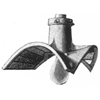

|
pinnacle
Introduced in 1932. Simpler form of lantern design for side street lighting.
In cases where economy has to be a deciding factor in a secondary lighting installation there is
a great demand for this fitting. The mirroring is carried out by a special process and is exactly similar
to that used by the Admiralty for Searchlights. Initially only 150W model available. Ideally suitable
for use with fluorescent treated lamps. Body is of cast iron, detachable top,
porcelain anti-vibrator lampholder. The mirrors are specially treated to avoid
deterioration and secured in the centre by a lead casting and at the other
ends by means of a lead strip. Made in two designs, 2-way and 3-way front extension and 3-way back
extension. One of six lanterns earmarked for post-war
production.
Later, for use with 80 and 125-watt mercury discharge lamps and gas-filled lamps
up to 200-watts. Many thousands of these fittings are in service in all parts
of the country. The detachable top and body are cast-iron, the top being held by
3 substantial screws. The porcelain lampholder is adjustable for correct focal
position and has an anti-vibration device which greatly reduces lamp breakage.
The mirrored reflecting surface is treated to withstand climatic conditions and
the individual sections are easily replaceable with the fitting in position.
The surfce of the mirrored reflectors is dimpled to minimize glare and great
care has been taken in setting them to obtain the best possible road illumination.
The fitting is supplied to give either 160° or 180° plan distribution.
|
|
HW ???
|
60-200W GLS
80-125W MB/U
|
BC
3BC
|
Top Entry
|
No Gear
|
1932 catalogue
1939 programme
1944 journal
1945 programme
1947 book
1951 book
|
|
|
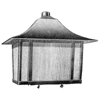
|
arterial
Introduced in 1936. For main road lighting. It is a new design of refractor panel
lantern which ensures maximum road intensity and good visibility without
glare. Incorporates several exclusive fetatures. Light is controlled
by prismatic refractor plates and an internal stainless steel reflector. The refractor
plates consists of a combination of horizontal and vertical prisms. The top set of
horizontal prisms control the light, which would normally come out in a horizontal
direction, and deflect it 10° dowwards. The bottom set of horizontal prisms give
a deflection of 10° upwards thus avoiding the high concentration of light
usually found near the pole. The internal stainless steel reflector controls
the upward light from the discharge lamp, and reflects it to the refractor plates.
|
|
HW ???
|
400W MA/V
|
GES
|
Top Entry
|
No Gear
|
1936 advert
1936 Paper
1936 Journal
|
|
|
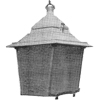

|
orbital
 See also Siemens Regent-Sieray
See also Siemens Regent-Sieray
First shown at the APLE's conference in Cheltenahm in 1936. Two-way directional lighting unit for
vertical-burning mercury discharge or gas filled lamps. A refractor
plate fitting with a unique design of top eliminating the
need for a connection box. The lamp holder is wired with asbestos flexible
to two substantial mica insulated terminals. There is no possibility of water entering the fitting
as the cast-iron top is solid right across, and domed and four large drain holes are provided. Ease of erection of
brackets has been studied as the lantern can be erected, ready for service,
in 20 minutes. For main road lighting. Comprises cast aluminium
alloy body, hinged cast iron top fitted with two mica insulted terminals
wired from the underside to the lampholder by means of heavy asbestos cable.
In 1944, the refractor plates were of improved design (see second image). A large door (11-in. by 8-in.) was fitted
at the bottom to give ready access to the interor. One of six lanterns earmarked for post-war
production. Used in ELECO's Campfield Road demonstation in 1944 burning vertical mercury lamps.
Fitted with specially designed refractor plates for light control, embodying horizontal and vertical prisms.
The horizontal prisms are in two sets, one at the top of the plate and one at the bottom. The top set controls
the upward light from the lamp, redirecting it down to the road surface. The bottom set refracts the lower
zone of light and redirects it to the road surface at between 40' and 75' from the standard, thus reducing
the high light concentration often found close to a standard.
|
|
HW ???
|
???W GLS
250-400W MA/V
|
GES
|
Top Entry
|
No Gear
|
1936 journal
1939 programme
1944 journal
1945 programme
1946 programme
1947 book
1947 advert
1947 advert
1951 book
|
|
|
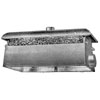
|
sunray
Cut-off fitting. Distribution being by means of specially designed mirrored reflectors which
are set at carefully definined angles so that the fullest possible use is made of the light for
road illumination. Spacings of up to 50 yards can be efficiently dealt with. In the top part of
the fitting, a diffusing panel is fitted so that some of the light above the horizontal passes through
this section and provides a reasonable amount of light above the fitting thus avoiding the
sharp contrast which is usually associated with cut-off fittings. A stainless steel top reflector and side reflectors
ensure the fullest possible use of the available light. For spacings up to 150'. The louvre top and glass side panels
allow some upward "spill" of light which prevents the depressing effect usually found with cut-off fittings.
The side mirrors are fixed at specific angles to deal with overlapping sections of the road. Their dimpled
surface eleminates glare and are easily replaceable. Top: cast iron; Ends: cast aluminium; sides: lead coated
sheet steel; mirror carriers: cast and angle brass.
|
|
HW ???
|
150W SO/H
|
BC
|
???
|
No Gear
|
1937 advert
1938 journal
1939 advert
1939 advert
|
|
|

|
golden ray
Also made as the MV Poplar.
Specially evolved for "Safety First" road lighting. Should be spaced in accordance with the
MOT's Interim and Final Reports (50 yards apart, staggered). Made in two sizes, one suitable for 50-60W SO/H lamps and the other suitable for
100-150W SO/H lamps. The canopy is made of cast iron. Top ends are made of cast aluminium alloy
whilst the refractor plate supports
are 1/16th in. copper channels. The lampholder is bakelite battern with special spring
contacts wired with an asbestos cable. Ther refractor plates have horizontal and
vertical prisms which give a non-axial distribution and are exclusive to this
fitting. If required, two-piece refractor plates can be supplied with smooth interior and exterior
surfaces for easy cleaning. The specially designed single piece refractor plates give a 160° distribution.
(This is changed in an advert to 170°). Two types of distribution can be given: (1) at 180° and
(2) at 160°. Main beams inclinded at an average of 73° from the vertical with peak candle power at 78°
By 1945, it had been further improved by the redesigning of the prismatic
plates - the top and ends are now made of cast iron. One of six lanterns earmarked for post-war
production. Two sizes used in ELECO's Campfield Road demonstation in 1944. Each of the refractor
plates has two sets of horizontal prisms and one set of vertical prisms. The former control the vertcial
light distribution, whilst the vertical prisms prevent excessive side spread and distribute it
reasonably with the limits of the roadway and pavement width. In 1947, the refractor plates are
described as 'exclusive' to the lantern, incorporating both horizontal and vertical prisms, which being on opposite faces
of the plates, do not intersect. If required lanterns can be supplied with two-piece refractor plates with smooth sides
on each exposed face.
|
|
HW ???
|
40-60W SO/H
85-140W SO/H
|
BC
|
Top entry
|
No Gear
|
1938 journal
1938 advert
1938 advert
1938 advert
1938 journal
1939 advert
1939 journal
1939 programme
1939 advert
1939 advert
1939 journal
1941 journal
1944 journal
1945 programme
1946 programme
1947 book
1947 programme
1947 advert
1947 journal
1947 paper
1951 book
|
|
|

|
highway
It controls the light from the whole length of the lamp. A novel feature is incorporated
in the reflecting system. Two swivelling and tilting mirrors are fitted relative to the upper
part of the lamp, permitting adjustment of the distribution in both horizontal and vertcial planes.
Four reflecting plates are fitted adjacent to the bottom half of the lamp, dealing similarly with
this portion. The whole length of the lamp is thus controlled and distributed in the lonitudinal direction
onto the road where it's required. The universal and complete adjustment allows the Highway
fitting to be used efficiently for varying heights and spacings and the horizontal swivelling of all
reflectors permits of uniform illumination on winding roads. Important installations are in service
at spacings of 200, 240 and 300 feet, where there is a remarkable evenness of distribution.
One of six lanterns earmarked for post-war production.
|
|
HW ???
|
250-400W MA/V
|
GES
|
???
|
No Gear
|
1944 journal
|
|
|

|
vapoura
See also Siemens Charlton-Sieray
Especially suitable for central suspension in large, open spaces where directional lighting is
not necessary. The glassware is rippled opalescent with the unique feature of easy cleaning, and though
rippled to improve diffusion, there are no ledges to collect dirt, and it is cleaned as easy as
a smooth surface. The special glass has a slightly corrective effect on the colour of the discharge lamp
and the resulting light will be found very pleasing indeed. A rippled opalescent glass bowl of the
same quality as the globe can be supplied to replace the bottom copper spinning when required.
One of six lanterns earmarked for post-war production.
|
|
HW ???
|
???W GLS
250-400WW MA/V
|
GES
|
Top Entry
|
No Gear
|
1938 advert
1944 journal
|
|
|

|
lanark
Two-way directional unit for use with horizontally burning Mercury discharge lamps.
The lantern can be fitted with magnetic control if required. It
is constructed from a cast iron detachable top (fitted with an inspection plate),
a copper canopy and cast aluminium alloy frames. The lampholder is porcelain
skirted GES adjustable. The optical system comprises refractor plates with
a main set of horizontal prisms and a secondary set of vertical prisms to
keep the plan spread within the bounds of the more ususal road widths. A large
internal reflector is incorporated to ensure maximum light utilisation. Connection box provided.
Distribution by two refractor plates combining horizontal and vertical prisms. The vertical prisms
prevent too much sideway spread of the light and keep the distribution within reasonable limits of
the road. One of six lanterns earmarked for post-war
production.
|
|
HW ???
|
400W MA/H
|
GES
|
Top Entry
|
No Gear
|
1939 programme
1939 advert
1939 advert
1944 journal
|
|
|

|
hamilton
Two-way directional lighting unit for vertical burning Mercury lamps.
The refractor bowl is securely held in a cast ring supported by a substantial hinge and swivel bolt.
Adaptable for top or side suspension. The body
is a one-piece aluminium alloy casting. Used in ELECO's Campfield Road demonstation in 1944 burning vertical mercury
fluorescent lamps. Light distribution achieved by means of a specially designed refractor bowl,
which is securely held in a cast ring hinged from the cast aluminium top, the complete unit being suitable
for either top or side mounting.
|
|
HW ???
|
250-400W MA/V
400W MAF/V
|
GES
|
Side / Top Entry
|
No Gear
|
1939 programme
1939 advert
1944 journal
1945 programme
1946 programme
|
|
|

|
hamilton junior
A bowl refractor fitting with external reflector. Described as new in 1939.
A light-weight fitting for use with 80W and 125W mercury lamps and 80W mercury fluorescent lamps.
Distribution is by means of a single piece, smooth exterior surface bowl.
In 1945, described as a sheet steel vitreous enamelled fitting with bowl refractor.
|
|
HW ???
|
80-125 MB/V
|
3BC
|
Top Entry
|
No Gear
|
1939 programme
1939 advert
1945 programme
|
|
|
|
|
tees
Described as an enclosed unit having either a clear outer globe with
internal band refractor for axialor non-axial distribution, or an opalescent
globe for symmetric distribution.
|
|
HW ???
|
80-125 MB/V
|
3BC
|
Top Entry
|
No Gear
|
1939 programme
|
|
|
|
|
calcutta duodome / calcutta
A fitting incorporating a dome type refractor. Described as eminently
suited to side-street lighting. By 1945, the lantern is simply called the
"Calcutta" and is fitted with a simple Duo Dome refractor for Group "B" lighting.
The Duo Dome is a two-piece refractor with smooth interior and exterior surfaces.
|
|
HW ???
|
60-200W GLS
80-125 MB/V
|
2BC
3BC
|
Top Entry
|
No Gear
|
1939 programme
1945 programme
1946 programme
|
|
|

|
welwyn
Also made as the MV Welwyn. Introduced in 1945. A one-piece aluminium alloy casting, with an
entirely new design of single piece refractor, giving two-way distribution at
170° in the horizontal plane. The refractor is fixed by means of phosphor
bronze clips and phosphor bronze springs, providing an easily detachable feature,
and at the same time a safe a firm fitting. Pre-determined fixing stops are incorporated
to ensure that each size of lamp is in correct focal position in relation to the refractor.
60/200 watt Tungsten lamps or 80 and 125-watt mercury lamps can be fitted.
|
|
HW ???
|
60-200W GLS
80-125W MB/U
|
BC
3BC
|
Top Entry
|
No Gear
|
1945 programme
1947 book
1951 book
|
|
|

|
ware
Also made as the MV Ryde.
Introduced in 1946. The "WARE" is similar in design and construction to the "Welwyn" but has an additional clear
outer globe held in a cast hinged ring; a combination of felt gaskets ensures that the
fitting is dust-proof. Provision is made for fixing a 16 in. diameter vitreous-enamelled
reflector if required.
|
|
HW ???
|
60-200W GLS
80-125W MB/U
|
BC
3BC
|
Top Entry
|
No Gear
|
1946 programme
1947 book
1951 book
|
|
|

|
baldock
Also made as the Crompton Sirius
with slight cosmetic changes. Introduced in 1946. In place of the dome refractor and clear outer globe of the "Ware",
the optical system of this lantern consists of a bowl refractor which is available to
give axial or non-axial distribution. The refractor is held in a cast hinged ring. A smooth exterior surface
facilitates maintenance and the fitting is dust-proof.
|
|
HW ???
|
60-200W GLS
80-125W MB/U
|
3BC
|
Top Entry
|
No Gear
|
1946 programme
1947 book
1951 book
|
|
|

|
royston
Introduced in 1946. The "ROYSTON", with an hexagonal body is cast in one piece and focal position for the
two sizes of lamps are incorporated. Consists of a one-piece aluminium alloy casting with a specially
designed refractor. The single piece dome refractor is available to give
symmetric, axial or non-axial distribution, and is held by an ingenious quick release device
based on the bayonet principle, which has the additional feature that it is impossible to
replace the refractor incorrectly when removed for cleaning. For use with 300/500 watt
Tungsten lamps or 80 and 125 watt merucry fluorescent lamps.
|
|
HW ???
|
300-500W GLS
80-125W MB/U
|
BC
3BC
|
Top Entry
|
No Gear
|
1946 programme
1947 book
1951 book
|
|
|
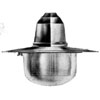
|
stevenage
Introduced in 1946. The "STEVENAGE" is similar to the "Royston" but with the addition of a clear outer glboe
which is held in a cast globe ring, the fitting being completely dust-proof.
|
|
HW ???
|
300-500W GLS
80-125W MB/U
|
BC
3BC
|
Top Entry
|
No Gear
|
1946 programme
1947 book
1951 book
|
|
|
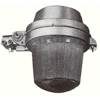
|
warwick
Described as 'lately added to the range' in 1951. A side-entry lantern for use with 250/400-watt MA/V or 125-watt MB/F
mercury lamps, the main body of which comprises an aluminium alloy casting to which the refrator retaining ring is secured
by a hinge and swivel bolt. A notable feature is the suspension assembly which permits irregularities up to 12° in column
or bracket alignment to be overcome. Except for a set of prisms at the back of the bowl to avoid waste of light behind the
fitting the bowl refractor has a smooth exteriro surface. A vitreous enamelled internal reflector ensures fullest light
utilisation. Immediate adjustment to the lampholder position can be effected to achieve correct focal relation between the
lamp and the refractor.
|
|
HW ???
|
250-400 MA/H
125W MB/F
|
GES
|
Side Entry
|
No Gear
|
1951 book
|
|
|

|
lancaster
Described as 'lately added to the range' in 1951. A side-entry lantern for 250/400-watt MA/H
horizontal-burning mercury discharge lamps, which combines the advantages of the increased lighting
efficiency possible with a horizontal source, a controlled cut-off distribution and the neat and general
appearance resulting from end suspension. Controlled cut-off distribution is effected by the positioning
of the light source well up in the body of the fitting, while light distribution is effected by a combination
of anodized aluminium internal side reflectors and the bottom refractor dish specially designed for use with
this type of fitting. The refractor prisms are carried in the inside of the dish having a smooth exterior surface.
|
|
HW ???
|
250-400W MA/H
|
ES
|
Side Entry
|
No Gear
|
1951 book
1953 advert
|
|
|

|
golden ray mk ii
Described as 'lately added to the range' in 1951. It is a top-entry lantern for use with 45/60-watt and 85/140-watt
SO/H sodium lamps, and is particularly suited for use in industrial areas where maintenance cleaning presents a serious
problem. The sealing of the external prisms of the refractor panels is augmented by the provision of a hinged "Perspex"
bottom door totally enclosing the lantern, a substantial white felt gasket eliminating the possibility of ingress of
atmospheric pollution.
|
|
HW ???
|
45-60W SO/H
85-140W SO/H
|
BC
|
Top Entry
|
No Gear
|
1951 book
|
|
|

|
aristocrat
Described as 'lately added to the range' in 1951. It is intended for use with tubular fluorescent MCF/U lamps, 2 x 80-watt
and 1 x 40-watt, and is designed to ensure ease of maintenance. The starter switches for the three lamps are housed externally
so that immediate access can be obtained. The main reflectors on either side of the fitting can be hinged away, exposing
the whole interior of the fitting.
|
|
HW ???
|
2 x 80W MCF/U
1 x 40W MCF/U
|
4 x BC
2 x BC
|
Side Entry
|
Gear
|
1951 book
|
|
|

|
|
|

|
welwyn
Also manufactured as the Crompton Star I with slight
cosmetic changes. Introduced in 1946. Consists of a one-piece aluminium alloy casting with an entirely
new design of single-piece refractor, giving two-day distribution at 170° in the horizontal plane. The
refractor is fixed by means of phosphor bronze clips and phosphor bronze springs, providing detachable feature,
and at the same time a safe and firm fixture.
|
|
HW ???
|
100-200W GLS
|
BC
|
Top Entry
|
No Gear
|
1953 advert
1953 advert
|
|
|

|
letchworth
Also manufactured as the Crompton Taurus with slight
cosmetic changes.
|
|
HW ???
|
100-200W GLS
|
BC
|
Top Entry
|
No Gear
|
1953 advert
|
|
|

|
universal 100
In 1954, it's the first street lighting lantern to utilise cast
Perspex tubing, incorporating a scientifically designed machined
Perspex prismatic formation and giving a symmetrical light distribution.
Designed as a low cost and high efficiency solution.
|
|
HW ???
|
100W GLS
|
BC
|
Top Entry
|
No Gear
|
ELECO Website
1954 advert
|
|
|
|
blackpool
Similar to Baldock Mk. II but side entry
|
|
HW ???
|
80-125W MBF/U
|
3BC
|
Side Entry
|
No Gear
|
1956 Journal
|
|
|
|
golden ray mk v
Open type lantern
|
|
HW ???
|
45-140W SO/H
|
BC
|
Side Entry
|
No Gear
|
1956 Journal
|
|
|
|
golden ray mk vi
Development of the MK III with gear-in-head
|
|
HW ???
|
???W SO/H
|
BC
|
Side Entry
|
Gear
|
1956 Journal
|
|
|
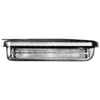
|
eleco two 727
Verically stacked tubes for road lighting?
|
|
HW 727
|
2x20W MCF
2x40W MCF
|
BC
|
Side Entry
|
Gear
|
1960s Catalogue
|
|
|

|
eleco two 727
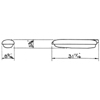
 For Group B and decorative street lighting. The canopy and bowl ring
are made from corrosion resistant die-cast aluminium alloy (LM6) and the lower enclosing bowl
is Perspex. The lantern is closed at one end by a stainless steel toggle catch, and the
joint gasketted against dirt and moisture. The lamps, holders and control gear are mounted on an
easily accessible hinged matt anodised aluminium reflector. A porcelain terminal block,
earth screw and cable clamp are provided. Quickstart gear is normally supplied, earth strip
lamps must be used and the lantern must be properly earthed. Weight 16 lbs.
Side entry only for 1" B.S.P. plain tube, minimum length 5", max 6", mounted horizontally
or at any suitable angle according to the bracket supplied. Possibly uses horizontally
positioned tubes for area lighting.
For Group B and decorative street lighting. The canopy and bowl ring
are made from corrosion resistant die-cast aluminium alloy (LM6) and the lower enclosing bowl
is Perspex. The lantern is closed at one end by a stainless steel toggle catch, and the
joint gasketted against dirt and moisture. The lamps, holders and control gear are mounted on an
easily accessible hinged matt anodised aluminium reflector. A porcelain terminal block,
earth screw and cable clamp are provided. Quickstart gear is normally supplied, earth strip
lamps must be used and the lantern must be properly earthed. Weight 16 lbs.
Side entry only for 1" B.S.P. plain tube, minimum length 5", max 6", mounted horizontally
or at any suitable angle according to the bracket supplied. Possibly uses horizontally
positioned tubes for area lighting.
|
|
HW 727
|
2x20W MCF
2x40W MCF
|
BC
|
Side Entry
|
Gear
|
1959 Catalogue
1960s Catalogue
|
|
|
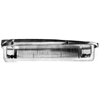
|
golden ray 280
First installed on the Glasgow-Edinburgh road between Baillieston
and Glasgow. The official switch-on took place at 9:40PM on 29th May 1958. The
lantern was designed by Denis R. Colvin, Esq., County Lighting Engineer to the
Lanarkshire County Council. The entire installation became a major showcase
for Philips, ELECO and Stewarts & Lloyds.
Later claimed to be the first motorway to be lit in Britain. The lantern itself
was held up as the first for a new era in Motorway and Major Road Lighting.
|
|
GR 280
|
Philips 280W SOI/H
|
2xBC
|
Side Entry
|
No Gear
|
ELECO Website
1960 advert
1960 advert
|
|
|

|
golden ray 2
This might be a renamed version of the Golden Ray 280
|
|
GR 2
|
???W
|
???
|
Side Entry
|
No Gear
|
1960s Catalogue
|
|
|

|
|
|

|
golden ray 200
Shallow bowl option.
|
|
HW ???
|
??? SOX
|
BC
|
Side Entry
|
No Gear
|
1960s Catalogue
|
|
|

|
|
|

|
|
|
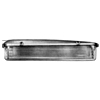
|
fluro ray 30
Probably takes multiple 30W fluorescent tubes. Body casting and bowl could be the same as the Golden Ray 280.
|
|
HW ???
|
??? MCF/U
|
BC
|
Side Entry
|
Gear
|
1960s Catalogue
|
|
|

|
fluro ray slim 80
Probably takes multiple 80W fluorescent tubes.
|
|
HW ???
|
??? MCF/U
|
BC
|
Side Entry
|
Gear
|
1960s Catalogue
|
|
|

|
eleco-way post top


 When fitted with a refractor dome, this lantern will give the usual Group B
lighting characteristics. When used without a refractor, a more general light distribution
will result. An attractive modern style lantern which is durable, strong and lightweight.
The top is hinged and gasketted to the clear perspex bowl, and secured by two toggle
clips. The base can be supplied to fit the majority of standard spigots; it is cast in
corrosion resistant aluminium alloy (LM6). This base is fitted with a porcelain connector
block, earth screw, cable clamp and supports the lampholder. Where required, a refractor
dome is fitted. Standard finish is stove enemelled white inside and aluminium outside.
Other colours in the I.C.I. range can be supplied to special order. AN OUTSTANDING FEATURE
OF THE PERSPEX BOWL IS ITS SINGLE PIECE, DEEP DRAWN CONSTRUCTION. THE ABSENCE OF SEAMS OR
JOINTS GIVES MAXIMUM STRENGTH AND RIGIDITY. The lantern is supplied with spigot cap, either
B.S. 3" x 3", or to suit the ELECOSLIM column. Location is by Allen screws.
When fitted with a refractor dome, this lantern will give the usual Group B
lighting characteristics. When used without a refractor, a more general light distribution
will result. An attractive modern style lantern which is durable, strong and lightweight.
The top is hinged and gasketted to the clear perspex bowl, and secured by two toggle
clips. The base can be supplied to fit the majority of standard spigots; it is cast in
corrosion resistant aluminium alloy (LM6). This base is fitted with a porcelain connector
block, earth screw, cable clamp and supports the lampholder. Where required, a refractor
dome is fitted. Standard finish is stove enemelled white inside and aluminium outside.
Other colours in the I.C.I. range can be supplied to special order. AN OUTSTANDING FEATURE
OF THE PERSPEX BOWL IS ITS SINGLE PIECE, DEEP DRAWN CONSTRUCTION. THE ABSENCE OF SEAMS OR
JOINTS GIVES MAXIMUM STRENGTH AND RIGIDITY. The lantern is supplied with spigot cap, either
B.S. 3" x 3", or to suit the ELECOSLIM column. Location is by Allen screws.
|
|
HW 828
|
100-200W GLS
80-125W MB/U
80-125W MBF/U
|
BC
3BC
3BC
|
Post Top
|
No Gear
|
1959 Catalogue
|
|
HW 880
|
100-200W GLS
80-125W MB/U
80-125W MBF/U
|
BC
3BC
3BC
|
Post Top
|
No Gear
|
1959 Catalogue
|
|
|

|
post top pt 828 (respecified version of above)
 For Group B lighting. A robust design of post top lantern with heavy duty cast
aluminium canopy, hinged to the perspex bowl and secured by means of stainless steel quick
action toggle clips. This ensures easy access to the interior of the lantern for maintenance
purposes. If required, this lantern can be fitted with an internal glass refractor. Available
with clear or Opal 030 bowl. Can be converted to take 35W SOX.
For Group B lighting. A robust design of post top lantern with heavy duty cast
aluminium canopy, hinged to the perspex bowl and secured by means of stainless steel quick
action toggle clips. This ensures easy access to the interior of the lantern for maintenance
purposes. If required, this lantern can be fitted with an internal glass refractor. Available
with clear or Opal 030 bowl. Can be converted to take 35W SOX.
|
|
PT 828
|
80-125W MBF/U
35W SOX
|
3BC/ES
BC
|
Post Top
|
No Gear
|
Sheet from 1970s
|
|
|

|
|
|

|
|
|
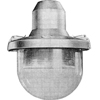
|
ware mk iii / ware mk 3

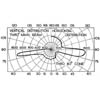
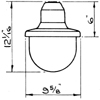
Complies with: BS 1788/1951
Refractor: ELECO HW.838
This lantern has a one-piece die-cast body and a die-cast bowl ring secured by stainless steel toggle
clips. Both castings are of corrosion resisting aluminium alloy LM6. A glass dome type dome refractor is
fitted and held securely in the correct position by means of clips with totally enclosed springs. The lampholder
bridge piece, which can be reversed to give alternative lamp positions has slotted ends for easy wiring and assembly.
A clear perspex bowl sealed against ingress of moisture or dust protects the lamp and refractor. Later also
available in CABULITE vandal resistant plastic. Weight 5½ lbs.
Refractors can be supplied to give symetrical or asymetrical light distributions. Top entry ¾" B.S.P. with locking screw.
|
|
HW 852
|
100-200W GLS
80-125W MB/U
80-125W MBF/U
|
BC
3BC
3BC
|
Top Entry
|
No Gear
|
1959 Catalogue
1960s Catalogue
Sheet from 1970s
|
|
|

|
|
|

|
eleco-way post top
 A general all-round illumination is obtained with a pleasing appearance and
absence of glare. An attractive modern style lantern which is durable, strong and
lightweight. The top is hinged and gasketted to the diffusing opal perspex bowl, and
secured by two toggle clips. The base can be supplied to fit the majority of standard
spigots; it is cast in corrosion resistant aluminium alloy (LM6). This base is fitted
with a porcelain connector block, earth screw, cable clamp and supports the lampholder.
Standard finish is stove enemelled white inside and aluminium outside. Other colours
in the I.C.I. range can be supplied to special order. A choice of two grades of
opalescence is available, either 030 or 040. AN OUTSTANDING FEATURE OF THE PERSPEX
BOWL IS ITS SINGLE PIECE, DEEP DRAWN CONSTRUCTION. THE ABSENCE OF SEAMS OR JOINTS
GIVES MAXIMUM STRENGTH AND RIGIDITY. The lantern is supplied with spigot cap, either B.S.
3" x 3", or to suit ELECOSLIM columns. Location is by Allen screws.
A general all-round illumination is obtained with a pleasing appearance and
absence of glare. An attractive modern style lantern which is durable, strong and
lightweight. The top is hinged and gasketted to the diffusing opal perspex bowl, and
secured by two toggle clips. The base can be supplied to fit the majority of standard
spigots; it is cast in corrosion resistant aluminium alloy (LM6). This base is fitted
with a porcelain connector block, earth screw, cable clamp and supports the lampholder.
Standard finish is stove enemelled white inside and aluminium outside. Other colours
in the I.C.I. range can be supplied to special order. A choice of two grades of
opalescence is available, either 030 or 040. AN OUTSTANDING FEATURE OF THE PERSPEX
BOWL IS ITS SINGLE PIECE, DEEP DRAWN CONSTRUCTION. THE ABSENCE OF SEAMS OR JOINTS
GIVES MAXIMUM STRENGTH AND RIGIDITY. The lantern is supplied with spigot cap, either B.S.
3" x 3", or to suit ELECOSLIM columns. Location is by Allen screws.
|
|
HW 877
|
100-200W GLS
80-125W MB/U
80-125W MBF/U
|
BC
3BC
3BC
|
Post Top
|
No Gear
|
1959 Catalogue
1965 catalogue
|
|
HW 878
|
100-200W GLS
80-125W MB/U
80-125W MBF/U
|
BC
3BC
3BC
|
Post Top
|
No Gear
|
1959 Catalogue
1965 catalogue
|
|
HW 879
|
45-60W SOI
|
BC
|
Post Top
|
No Gear
|
1959 Catalogue
1965 catalogue
|
|
|

|
eleco-way slim post top
 A general all-round illumination is obtained with a pleasing appearance
and absence of glare. Another very modern and pleasing Post Top design, similar to
the ELECO-Way, but with greater height and having a smaller diameter opalised perspex
bowl without curved sides and with a smaller diameter top canopy. The lantern top is
gasketted to the diffusing opal perspex bowl, and secured by toggle clips. The base
is cast in corrosion resistant aluminium alloy (LM6). This base is fitted with a
porcelain connector block, earth screw, cable clamp, and also supports the lampholder.
Standard finish is stove enemelled white inside and aluminium outside. Other colours
in the I.C.I. range can be supplied to special order. A choice of two grades of
opalescence is available, either 030 or 040. Refractors are not fitted as standard
in this type of lantern, which is designed to be as simple and functional as possible,
but if especially required, a refracor can be supplied with the 030 opalescent bowl.
AN OUTSTANDING FEATURE OF THE PERSPEX BOWL IS ITS SINGLE PIECE, DEEP DRAWN CONSTRUCTION.
THE ABSENCE OF SEAMS OR JOINTS GIVES MAXIMUM STRENGTH AND RIGIDITY. The lantern is
supplied with spigot cap either B.S. 3"x3" or to suit ELECOSLIM columns.
Location is by Allen screws.
A general all-round illumination is obtained with a pleasing appearance
and absence of glare. Another very modern and pleasing Post Top design, similar to
the ELECO-Way, but with greater height and having a smaller diameter opalised perspex
bowl without curved sides and with a smaller diameter top canopy. The lantern top is
gasketted to the diffusing opal perspex bowl, and secured by toggle clips. The base
is cast in corrosion resistant aluminium alloy (LM6). This base is fitted with a
porcelain connector block, earth screw, cable clamp, and also supports the lampholder.
Standard finish is stove enemelled white inside and aluminium outside. Other colours
in the I.C.I. range can be supplied to special order. A choice of two grades of
opalescence is available, either 030 or 040. Refractors are not fitted as standard
in this type of lantern, which is designed to be as simple and functional as possible,
but if especially required, a refracor can be supplied with the 030 opalescent bowl.
AN OUTSTANDING FEATURE OF THE PERSPEX BOWL IS ITS SINGLE PIECE, DEEP DRAWN CONSTRUCTION.
THE ABSENCE OF SEAMS OR JOINTS GIVES MAXIMUM STRENGTH AND RIGIDITY. The lantern is
supplied with spigot cap either B.S. 3"x3" or to suit ELECOSLIM columns.
Location is by Allen screws.
|
|
HW 895
|
100-200W GLS
80-125W MB/U
80-125W MBF/U
|
BC
3BC
3BC
|
Post Top
|
No Gear
|
1959 Catalogue
|
|
HW 896
|
100-200W GLS
80-125W MB/U
80-125W MBF/U
|
BC
3BC
3BC
|
Post Top
|
No Gear
|
1959 Catalogue
|
|
HW 897
|
45-60W SOI
|
BC
|
Post Top
|
No Gear
|
1959 Catalogue
|
|
HW 898
|
45-60W SOI
|
BC
|
Post Top
|
No Gear
|
1959 Catalogue
|
|
|

|
post top pt 895 (respecified version of above)
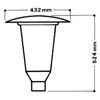 For Group B lighting. A robust design of post top lantern with heavy duty cast
aluminium canopy, hinged to the perspex bowl and secured by means of stainless steel quick
action toggle clips. This ensures easy access to the interior of the lantern for maintenance
purposes. If required, this lantern can be fitted with an internal glass refractor. Available
with clear or Opal 030 bowl. Can be converted to take 35W SOX.
For Group B lighting. A robust design of post top lantern with heavy duty cast
aluminium canopy, hinged to the perspex bowl and secured by means of stainless steel quick
action toggle clips. This ensures easy access to the interior of the lantern for maintenance
purposes. If required, this lantern can be fitted with an internal glass refractor. Available
with clear or Opal 030 bowl. Can be converted to take 35W SOX.
|
|
PT 895
|
80-125W MBF/U
35W SOX
|
3BC/ES
BC
|
Post Top
|
No Gear
|
Sheet from 1970s
|
|
|

|
eleco-way 907 post top
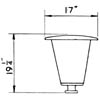 Approved by The Council Of Industrial Design.
Approved by The Council Of Industrial Design.
A general all-round illumination is obtained with a pleasing appearance
and absence of glare. Another very modern and pleasing Post Top design, similar to
the ELECO-Way, but with greater height and having a smaller diameter opalised perspex
bowl without curved sides and with a smaller diameter top canopy. The lantern top is
gasketted to the diffusing opal perspex bowl, and secured by toggle clips. The base
is cast in corrosion resistant aluminium alloy (LM6). This base is fitted with a
porcelain connector block, earth screw, cable clamp, and also supports the lampholder.
Standard finish is stove enemelled white inside and aluminium outside. Other colours
in the I.C.I. range can be supplied to special order. A choice of two grades of
opalescence is available, either 030 or 040. Refractors are not fitted as standard
in this type of lantern, which is designed to be as simple and functional as possible,
but if especially required, a refracor can be supplied with the 030 opalescent bowl.
AN OUTSTANDING FEATURE OF THE PERSPEX BOWL IS ITS SINGLE PIECE, DEEP DRAWN CONSTRUCTION.
THE ABSENCE OF SEAMS OR JOINTS GIVES MAXIMUM STRENGTH AND RIGIDITY. The lantern is
supplied with spigot cap suitable for 1¼" B.S.P plain. 3 3/8" maximum length.
Location is by Allen screws.
|
|
HW 907-1
|
100-200W GLS
80-125W MB/U
80-125W MBF/U
|
BC
3BC
3BC
|
Post Top
|
No Gear
|
1959 Catalogue
|
|
HW 907-2
|
100-200W GLS
80-125W MB/U
80-125W MBF/U
|
BC
3BC
3BC
|
Post Top
|
No Gear
|
1959 Catalogue
|
|
HW 907-3
|
45-60W SOI
|
BC
|
Post Top
|
No Gear
|
1959 Catalogue
|
|
HW 907-4
|
45-60W SOI
|
BC
|
Post Top
|
No Gear
|
1959 Catalogue
|
|
|

|
eleco-way 908 post top
 Approved by The Council Of Industrial Design.
Approved by The Council Of Industrial Design.
A general all-round illumination is obtained with a pleasing appearance
and absence of glare. Another very modern and pleasing Post Top design, similar to
the ELECO-Way, but with greater height and having a small diameter opalised perspex
bowl without curved sides and with a smaller diameter top canopy. The lantern top is
gasketted to the diffusing opal perspex bowl, and secured by toggle clips. The base
is cast in corrosion resistant aluminium alloy (LM6). This base is fitted with a
porcelain connector block, earth screw, cable clamp, and also supports the lampholder.
Standard finish is stove enemelled white inside and aluminium outside. Other colours
in the I.C.I. range can be supplied to special order. A choice of two grades of
opalescence is available, either 030 or 040. Refractors are not fitted as standard
in this type of lantern, which is designed to be as simple and functional as possible,
but if especially required, a refracor can be supplied with the 030 opalescent bowl.
AN OUTSTANDING FEATURE OF THE PERSPEX BOWL IS ITS SINGLE PIECE, DEEP DRAWN CONSTRUCTION.
THE ABSENCE OF SEAMS OR JOINTS GIVES MAXIMUM STRENGTH AND RIGIDITY. The lantern is
supplied with spigot cap suitable for 1¼" B.S.P plain. 3 3/8" maximum length.
Location is by Allen screws.
|
|
HW 908-1
|
100-200W GLS
80-125W MB/U
80-125W MBF/U
|
BC
3BC
3BC
|
Post Top
|
No Gear
|
1959 Catalogue
1960s Catalogue
1965 catalogue
1965 catalogue
|
|
HW 908-2
|
100-200W GLS
80-125W MB/U
80-125W MBF/U
|
BC
3BC
3BC
|
Post Top
|
No Gear
|
1959 Catalogue
1960s Catalogue
1965 catalogue
1965 catalogue
|
|
HW 908-3
|
45-60W SOI
|
BC
|
Post Top
|
No Gear
|
1959 Catalogue
1960s Catalogue
1965 catalogue
1965 catalogue
|
|
HW 908-4
|
45-60W SOI
|
BC
|
Post Top
|
No Gear
|
1959 Catalogue
1960s Catalogue
1965 catalogue
1965 catalogue
|
|
|

|
post top pt 908 (respecified version of above)
 For Group B lighting. A robust design of post top lantern with heavy duty cast aluminium canopy, hinged to
the perspex bowl and secured by means of stainless steel quick action toggle clips. This ensures
easy access to the interior of the lantern for maintenance purposes. If required, this lantern
can be fitted with an internal glass refractor.
For Group B lighting. A robust design of post top lantern with heavy duty cast aluminium canopy, hinged to
the perspex bowl and secured by means of stainless steel quick action toggle clips. This ensures
easy access to the interior of the lantern for maintenance purposes. If required, this lantern
can be fitted with an internal glass refractor.
|
|
PT 908
|
80-125W MBF/U
35W SOX
|
3BC/ES
BC
|
Post Top
|
No Gear
|
Sheet from 1970s
|
|
|

|
|
|

|
|
|

|
|
|

|
|
|

|
silver ray
Specially designed for the new 250/400W MBF/U lamp in 1957. Appears to use Holophane
refractor bowl. Used where colour rendering is of prime importance such as in shopping
areas. The lantern has attractive styling with clean lines.
|
|
HW ???
|
250-400W MBF/U
|
GES
|
Side Entry
|
No Gear
|
ELECO Website
|
|
|
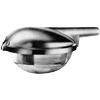
|
|
|
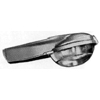
|
|
silver ray with gear in hood
|
|
HW ???
|
???W MBF/U
|
???
|
Side Entry
|
Gear
|
1960s Catalogue
|
|
|

|
golden ray 100
Also manufactured as the Crompton Golden Ray.
Compiles with: CP 1004: Part 2: 1963
Compiles with: BS 1788:1964
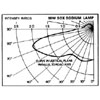
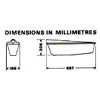 Semi-cut-off distribution. Corrosion resistant die-cast aluminium alloy (LM6M) canopy and bowl ring: one piece acrylic
bowl with sealed on machined and polished refractor plates. Inside of canopy stoved white,
fully gasketted with Neoprene strip to eliminate dirt and moisture; fitted porcelain terminal
block, earth screw and cable clamp. Porcelain B.C. lampholder with heat resisting leads. Stainless
steel hinge pins and 'quick action' spring clips. Photocell an optional extra. Semi-cut-off sodium
lantern suitable for groups A1, A2 and A3 roads at 8m mounting heights. Weight 2.95kg.
Semi-cut-off distribution. Corrosion resistant die-cast aluminium alloy (LM6M) canopy and bowl ring: one piece acrylic
bowl with sealed on machined and polished refractor plates. Inside of canopy stoved white,
fully gasketted with Neoprene strip to eliminate dirt and moisture; fitted porcelain terminal
block, earth screw and cable clamp. Porcelain B.C. lampholder with heat resisting leads. Stainless
steel hinge pins and 'quick action' spring clips. Photocell an optional extra. Semi-cut-off sodium
lantern suitable for groups A1, A2 and A3 roads at 8m mounting heights. Weight 2.95kg.
|
|
GR 100
|
90W SOX
|
BC
|
Side Entry
|
No Gear
|
Sheet from 1970s
|
|
|
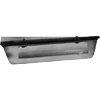
|
golden ray 101
Compiles with: CP 1004: Part 2: 1963
Compiles with: BS 1788:1964

 Cut-off distribution. Corrosion resistant die-cast aluminium alloy (LM6M) canopy and bowl ring: one piece acrylic bowl.
Side reflectors manufactured from super purity magnesium aluminium alloy, chemically brightened
and anodised, rivetted to the internal surfaces of the bowl. Canopy stoved enamelled and fully
gasketted with tropicalised felt against the ingress of dirt and moisture; fitted porcelain
terminal block, earth screw and cable clamp. Porcelain B.C. lampholder with heat resisting leads.
Stainless steel hinge pins and 'quick action' spring clips. Suitable for group A1 roads at 8 metres
mounting height and groups A2 and A3 up to 10 meters. Weight 3.18kg.
Cut-off distribution. Corrosion resistant die-cast aluminium alloy (LM6M) canopy and bowl ring: one piece acrylic bowl.
Side reflectors manufactured from super purity magnesium aluminium alloy, chemically brightened
and anodised, rivetted to the internal surfaces of the bowl. Canopy stoved enamelled and fully
gasketted with tropicalised felt against the ingress of dirt and moisture; fitted porcelain
terminal block, earth screw and cable clamp. Porcelain B.C. lampholder with heat resisting leads.
Stainless steel hinge pins and 'quick action' spring clips. Suitable for group A1 roads at 8 metres
mounting height and groups A2 and A3 up to 10 meters. Weight 3.18kg.
|
|
GR 101
|
90W SOX
|
BC
|
Side Entry
|
No Gear
|
Sheet from 1970s
|
|
|
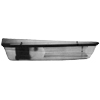
|
golden ray 102
Compiles with: CP 1004: Part 2: 1963
Compiles with: BS 1788:1964
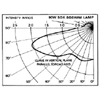
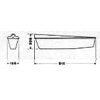 Semi-cut-off distribution. Corrosion resistant die-cast aluminium alloy (LM6M) canopy and bowl ring:
one piece acrylic bowl with sealed on machined and polished refractor plates. Inside of canopy stoved white,
fully gasketted with Noeprene strip to eliminate dirt and moisture; fitted porcelain terminal block, earth
screw and cable clamp. Porcelain B.C. lampholder with heat resisting leads. Stainless steel hinge pins and
'quick action' spring clips. The lantern has integral control gear mounted in the canopy.
suitable for groups A1, A2 and A3 roads at 8m mounting heights. Weight: 10.43kg
Semi-cut-off distribution. Corrosion resistant die-cast aluminium alloy (LM6M) canopy and bowl ring:
one piece acrylic bowl with sealed on machined and polished refractor plates. Inside of canopy stoved white,
fully gasketted with Noeprene strip to eliminate dirt and moisture; fitted porcelain terminal block, earth
screw and cable clamp. Porcelain B.C. lampholder with heat resisting leads. Stainless steel hinge pins and
'quick action' spring clips. The lantern has integral control gear mounted in the canopy.
suitable for groups A1, A2 and A3 roads at 8m mounting heights. Weight: 10.43kg
|
|
GR 102
|
90W SOX
|
BC
|
Side Entry
|
Gear
|
Sheet from 1970s
|
|
|

|
golden ray 110
Compiles with: CP 1004: Part 2: 1963
Compiles with: BS 1788:1964

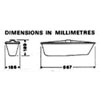 Semi-cut-off distribution. Corrosion resistant die-cast aluminium alloy (LM6M) canopy and bowl ring:
one piece acrylic bowl with sealed on machined and polished refractor plates. Inside of canopy stoved white,
fully gasketted with Noeprene strip to eliminate dirt and moisture; fitted porcelain terminal block, earth
screw and cable clamp. Suitable for groups A1, A2 and A3 roads at 8m mounting heights.
Porcelain B.C. lampholder with heat resisting leads. Stainless steel hinge pins and
'quick action' spring clips. Weight: 2.95kg.
Semi-cut-off distribution. Corrosion resistant die-cast aluminium alloy (LM6M) canopy and bowl ring:
one piece acrylic bowl with sealed on machined and polished refractor plates. Inside of canopy stoved white,
fully gasketted with Noeprene strip to eliminate dirt and moisture; fitted porcelain terminal block, earth
screw and cable clamp. Suitable for groups A1, A2 and A3 roads at 8m mounting heights.
Porcelain B.C. lampholder with heat resisting leads. Stainless steel hinge pins and
'quick action' spring clips. Weight: 2.95kg.
|
|
GR 110
|
90W SOX
|
BC
|
Top Entry
|
No Gear
|
Sheet from 1970s
|
|
|

|
golden ray 150
Also manufactured as the Crompton Golden Ray.
Compiles with: CP 1004: Part 2: 1963
Compiles with: BS 1788:1964

 Semi-cut-off distribution. Corrosion resistant die-cast aluminium alloy (LM6M) canopy and bowl ring;
one piece acrylic bowl with sealed on machined and polished refractor plates. Inside of canopy stove white, fully
gasketted with Neoprene strip to eliminate dirt and moisture; fitted porcelain terminal block, earth screw and
cable clamp. Porcelain B.C. lampholder with heat resisting leads. Stainless steel hinge pins and quick action
toggle catches. Semi-cut-off sodium suitable for groups A1, A2 and A3 roads, up to 35 ft. (10m) mounting heights.
Side entry 1¼" B.S.P plain pipe 5" maximum length, secured by two Allen screws. Weight 9½ lbs. (4.31kg).
Semi-cut-off distribution. Corrosion resistant die-cast aluminium alloy (LM6M) canopy and bowl ring;
one piece acrylic bowl with sealed on machined and polished refractor plates. Inside of canopy stove white, fully
gasketted with Neoprene strip to eliminate dirt and moisture; fitted porcelain terminal block, earth screw and
cable clamp. Porcelain B.C. lampholder with heat resisting leads. Stainless steel hinge pins and quick action
toggle catches. Semi-cut-off sodium suitable for groups A1, A2 and A3 roads, up to 35 ft. (10m) mounting heights.
Side entry 1¼" B.S.P plain pipe 5" maximum length, secured by two Allen screws. Weight 9½ lbs. (4.31kg).
|
|
GR 150
|
150W SOX
135W SOX
|
BC
|
Side Entry
|
No Gear
|
1965 catalogue
Sheet from 1965
Sheet from 1970s
|
|
|

|
golden ray 151
Compiles with: CP 1004: Part 2: 1963
Compiles with: BS 1788:1964
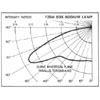
 Cut-off distribution.
Corrosion resistant die-cast aluminium alloy (LM6M) canopy and bowl ring: one piece acrylic bowl. Side
relfectors manufactured from super purity magnesium aluminium alloy, chemically brightened and anodised,
rivetted to the internal surfaces of the bowl. Canopy stoved enamelled and fully gasketted with tropicalised
felt against the ingress or dirt and moisture; fitted porcelain terminal block, earth screw and cable clamp.
Porcelain B.C. lampholder with heat resisting leads. Stainless steel hinge pins and 'quick action' spring clips.
Suitable for groups A1 and A2 up to 10 meters mounting height. Suitable for use on trunk roads.
Cut-off distribution.
Corrosion resistant die-cast aluminium alloy (LM6M) canopy and bowl ring: one piece acrylic bowl. Side
relfectors manufactured from super purity magnesium aluminium alloy, chemically brightened and anodised,
rivetted to the internal surfaces of the bowl. Canopy stoved enamelled and fully gasketted with tropicalised
felt against the ingress or dirt and moisture; fitted porcelain terminal block, earth screw and cable clamp.
Porcelain B.C. lampholder with heat resisting leads. Stainless steel hinge pins and 'quick action' spring clips.
Suitable for groups A1 and A2 up to 10 meters mounting height. Suitable for use on trunk roads.
|
|
GR 151
|
135W SOX
|
BC
|
Side Entry
|
No Gear
|
Sheet from 1970s
|
|
|
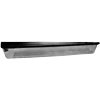
|
golden ray 200
Compiles with: CP 1004: Part 2: 1963
Compiles with: BS 1788:1964

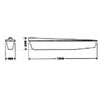 Semi-cut-off distribution. Corrosion resistant die-cast aluminium alloy (LM6M) canopy and bowl ring:
one piece acrylic bowl with sealed on machined and polished refractor plates.
Inside of canopy stoved white, fully gasketted with Neoprene strip to eliminate
dirt and moisture; fitted porcelain terminal block, earth screw and cable clamp.
Porcelain B.C. lampholder with heat resisting leads. Stainless steel hinge pins and
'quick action' spring clips.
Semi-cut-off distribution. Corrosion resistant die-cast aluminium alloy (LM6M) canopy and bowl ring:
one piece acrylic bowl with sealed on machined and polished refractor plates.
Inside of canopy stoved white, fully gasketted with Neoprene strip to eliminate
dirt and moisture; fitted porcelain terminal block, earth screw and cable clamp.
Porcelain B.C. lampholder with heat resisting leads. Stainless steel hinge pins and
'quick action' spring clips.
|
|
GR 200
|
180W SOX
|
BC
|
Side Entry
|
No Gear
|
Sheet from 1970s
|
|
|
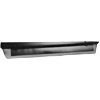
|
golden ray 201
Compiles with: CP 1004: Part 2: 1963
Compiles with: BS 1788:1964
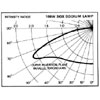
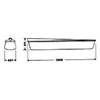 Cut-off distribution. Corrosion resistant die-cast aluminium alloy (LM6M) canopy and bowl
ring: one piece acrylic bowl. Side reflectors manufactured from super purity magnesium aluminium alloy,
chemically brightened and anodised, rivetted to the internal surfaces of the bowl. Canopy stoved enamelled and
fully gasketted with tropicalised felt against the ingress or dirt and moisture; fitted porcelain terminal block,
earth screw and cable clamp. Porcelain B.C. lampholder with heat resisting leads. Stainless steel hinge pins
and quick action spring clips. Suitable for groups A1, A2 and A3 roads up to 12 meters mounting height.
Weight: 6.35kgs
Cut-off distribution. Corrosion resistant die-cast aluminium alloy (LM6M) canopy and bowl
ring: one piece acrylic bowl. Side reflectors manufactured from super purity magnesium aluminium alloy,
chemically brightened and anodised, rivetted to the internal surfaces of the bowl. Canopy stoved enamelled and
fully gasketted with tropicalised felt against the ingress or dirt and moisture; fitted porcelain terminal block,
earth screw and cable clamp. Porcelain B.C. lampholder with heat resisting leads. Stainless steel hinge pins
and quick action spring clips. Suitable for groups A1, A2 and A3 roads up to 12 meters mounting height.
Weight: 6.35kgs
|
|
GR 201
|
180W SOX
|
BC
|
Side Entry
|
No Gear
|
Sheet from 1970s
|
|
|

|
golden ray 60 | golden ray 501
Also manufactured as the Crompton Golden Ray.
Compiles with: BS 1788:1964
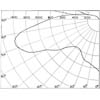
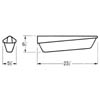 Originally called the Golden Ray 60 (as it took 60W SOI or 60W SLI/H). Original models also
had a bowl ring and acrylic bowl.
Corrosion resistant die-cast aluminium alloy (LM6M) canopy and bowl ring; one piece acrylic bowl with sealed on
refractor plates. Canopy stove enamelled. The lantern is fully gasketted to eliminate dirt and moisture; fitted
porcelain terminal block, earth screw and cable clamp. Porcelain B.C. lampholder with heat resisting leads.
Stainless steel hinge pin and quick action toggle catch. The bowl complete with bowl ring is easily removable.
Main beam designed to have a sharp run back to 90° from the downward vertical giving maximum control, thus
reducing glare to a minimum. Side entry 1" BS plain pipe 3½" maximum length, secured by two Allen screws.
Weight 5 lbs. Lampholder on path side of the lantern. Appears to have been superceeded by the ELECO GR5011 (see below).
Originally called the Golden Ray 60 (as it took 60W SOI or 60W SLI/H). Original models also
had a bowl ring and acrylic bowl.
Corrosion resistant die-cast aluminium alloy (LM6M) canopy and bowl ring; one piece acrylic bowl with sealed on
refractor plates. Canopy stove enamelled. The lantern is fully gasketted to eliminate dirt and moisture; fitted
porcelain terminal block, earth screw and cable clamp. Porcelain B.C. lampholder with heat resisting leads.
Stainless steel hinge pin and quick action toggle catch. The bowl complete with bowl ring is easily removable.
Main beam designed to have a sharp run back to 90° from the downward vertical giving maximum control, thus
reducing glare to a minimum. Side entry 1" BS plain pipe 3½" maximum length, secured by two Allen screws.
Weight 5 lbs. Lampholder on path side of the lantern. Appears to have been superceeded by the ELECO GR5011 (see below).
|
|
GR 501
|
60-85W SOI/H
40-60W SOX
|
BC
|
Side Entry
|
No Gear
|
1960s Catalogue
1965 catalogue
Sheet from 1965
|
GR 503
|
60W SLI/H
|
2xBC
|
Side Entry
|
No Gear
|
1960s Catalogue
Sheet from 1965
|
|
|

|
golden ray 5011
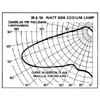
 Appears to be a modification of the ELECO GR501 (see above) but
with the lampholder relocated to the street side of the lantern. This has affected the
optical characteristics - appears to have more of a cut-off than its predecessor.
Corrosion resistant die-cast aluminium alloy (LM6M) canopy and bowl ring: one
piece acrylic bowl with sealed on refractor plates and may be supplied with
C.A.B. vandal resistant bowl as an alternative. Canopy stove enamelled.
The lantern is fully gasketted to eliminate dirt and moisture; fitted porcelain
terminal block, earth screw and cable clamp. Porcelain B.C. lampholder with heat resisting
leads. Stainless steel hinge pins and 'quick action' spring clips. The bowl complete with
bowl ring is easily removable. Main beam designed to have a sharp run back to 90° from
the downward vertical giving maximum control, thus reducing glare to a minimum. ELECO
GR510 is fitted with P8 photocell.
Appears to be a modification of the ELECO GR501 (see above) but
with the lampholder relocated to the street side of the lantern. This has affected the
optical characteristics - appears to have more of a cut-off than its predecessor.
Corrosion resistant die-cast aluminium alloy (LM6M) canopy and bowl ring: one
piece acrylic bowl with sealed on refractor plates and may be supplied with
C.A.B. vandal resistant bowl as an alternative. Canopy stove enamelled.
The lantern is fully gasketted to eliminate dirt and moisture; fitted porcelain
terminal block, earth screw and cable clamp. Porcelain B.C. lampholder with heat resisting
leads. Stainless steel hinge pins and 'quick action' spring clips. The bowl complete with
bowl ring is easily removable. Main beam designed to have a sharp run back to 90° from
the downward vertical giving maximum control, thus reducing glare to a minimum. ELECO
GR510 is fitted with P8 photocell.
|
|
GR 5011
|
35W-55W SOX
|
BC
|
Side Entry
|
No Gear
|
Sheet from 1970s
|
|
GR 510
|
35W-55W SOX
|
BC
|
Side Entry
|
No Gear
|
Sheet from 1970s
|
|
|
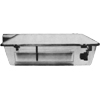
|
golden ray 550
Compiles with: BS 1788:1964
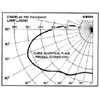
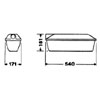 Group B lantern. Corrosion resistant die-cast aluminium alloy (LM6M) canopy and bowl ring: one piece
acrylic bowl with sealed on machined and polished refractor plates and stainless steel spring
clips and hinges attached. The canopy is fully gasketted with tropicalised felt against the ingress of
dirt and mositure; fitted cable clamps, porcelain terminal block, earth screw and
porcelain B.C. lampholder with heat resisting leads. GR551 has integrated control gear (suitable for both 35 and 55 Watt SOX lamps) mounted on
a detachable, galvanized steel gear tray. C.A.B. vandal resistant bowl also available.
Weights 2.50kgs (GR550) and 7.94kgs (GR551).
Group B lantern. Corrosion resistant die-cast aluminium alloy (LM6M) canopy and bowl ring: one piece
acrylic bowl with sealed on machined and polished refractor plates and stainless steel spring
clips and hinges attached. The canopy is fully gasketted with tropicalised felt against the ingress of
dirt and mositure; fitted cable clamps, porcelain terminal block, earth screw and
porcelain B.C. lampholder with heat resisting leads. GR551 has integrated control gear (suitable for both 35 and 55 Watt SOX lamps) mounted on
a detachable, galvanized steel gear tray. C.A.B. vandal resistant bowl also available.
Weights 2.50kgs (GR550) and 7.94kgs (GR551).
|
|
GR 550
|
35W-55W SOX
|
BC
|
Side Entry
|
No Gear
|
Sheet from 1970s
|
|
GR 551
|
35W-55W SOX
|
BC
|
Side Entry
|
Gear
|
Sheet from 1970s
|
|
|

|
golden ray 552
Compiles with: BS 1788:1964
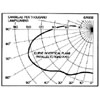
 Group B lantern. Corrosion resistant die-cast aluminium alloy (LM6M) canopy and bowl ring: one piece
acrylic bowl with sealed on machined and polished refractor plates and stainless steel spring
clips and hinges attached. The canopy is fully gasketted with tropicalised felt against the ingress of
dirt and mositure; fitted cable clamps, porcelain terminal block, earth screw and
porcelain B.C. lampholder with heat resisting leads. GR551 has integrated control gear (suitable for both 35 and 55 Watt SOX lamps) mounted on
a detachable, galvanized steel gear tray. C.A.B. vandal resistant bowl also available.
Weights 2.50kgs (GR552) and 7.94kgs (GR553).
Group B lantern. Corrosion resistant die-cast aluminium alloy (LM6M) canopy and bowl ring: one piece
acrylic bowl with sealed on machined and polished refractor plates and stainless steel spring
clips and hinges attached. The canopy is fully gasketted with tropicalised felt against the ingress of
dirt and mositure; fitted cable clamps, porcelain terminal block, earth screw and
porcelain B.C. lampholder with heat resisting leads. GR551 has integrated control gear (suitable for both 35 and 55 Watt SOX lamps) mounted on
a detachable, galvanized steel gear tray. C.A.B. vandal resistant bowl also available.
Weights 2.50kgs (GR552) and 7.94kgs (GR553).
|
|
GR 552
|
35W-55W SOX
|
BC
|
Top Entry
|
No Gear
|
Sheet from 1970s
|
|
GR 553
|
35W-55W SOX
|
BC
|
Top Entry
|
Gear
|
Sheet from 1970s
|
|
|

|
post top pt 1001
 For Group B lighting. A versatile post top lantern designed for use
with 35/55 watt SOX lamp and available with 75mm or ELECOSlim spigot. Canopy
top is an aluminium spinning, gasketed to the acrylic bowl and secured by
a central die-cast knob. This allows quick and easy access to the interior
of the lantern for maintenance purposes.
For Group B lighting. A versatile post top lantern designed for use
with 35/55 watt SOX lamp and available with 75mm or ELECOSlim spigot. Canopy
top is an aluminium spinning, gasketed to the acrylic bowl and secured by
a central die-cast knob. This allows quick and easy access to the interior
of the lantern for maintenance purposes.
|
|
PT 1001
|
35W-55W SOX
|
BC
|
Post Top
|
No Gear
|
Sheet from 1970s
|
|
|

|
post top pt 1004
 For Group B lighting. This is a post top lantern of modern design for use
with 80/125 watt MBF/U lamp. The canopy top is an aluminium spinning, gasketed to the opal acrylic
bowl and secured by a central die-cast knob. An alternative bowl is available manufactured from vandal
resistant Cabulite. Both canopy and bowl are designed for quick release to simplify maintenance.
For Group B lighting. This is a post top lantern of modern design for use
with 80/125 watt MBF/U lamp. The canopy top is an aluminium spinning, gasketed to the opal acrylic
bowl and secured by a central die-cast knob. An alternative bowl is available manufactured from vandal
resistant Cabulite. Both canopy and bowl are designed for quick release to simplify maintenance.
|
|
PT 1004
|
80-125W MBF/U
|
3BC
|
Post Top
|
No Gear
|
Sheet from 1970s
|
|
|

|
post top pt 1006 lunar
 For Group B lighting. It is the ultra modern "LUNAR" post top lantern
designed for use with 35 watt SOX lamp and with 75x75mm spigot. The canopy top is an aluminium
spinning, gasketed to the opal acrylic bowl and secured by a central die-cast knob. This allows
quick and easy access to the interior of the lantern for maintenance purposes. It's also
available with Cabulite vandal resistant bowl if required.
For Group B lighting. It is the ultra modern "LUNAR" post top lantern
designed for use with 35 watt SOX lamp and with 75x75mm spigot. The canopy top is an aluminium
spinning, gasketed to the opal acrylic bowl and secured by a central die-cast knob. This allows
quick and easy access to the interior of the lantern for maintenance purposes. It's also
available with Cabulite vandal resistant bowl if required.
|
|
PT 1006
|
35W SOX
|
BC
|
Post Top
|
No Gear
|
Sheet from 1970s
|
|
PT 1007
|
80-125W MBF/U
|
3BC
ES
|
Post Top
|
No Gear
|
Sheet from 1970s
|
|
|
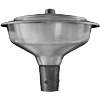
|
post top pt 1013
 For Group B lighting. A post top lantern of pleasing design for use with
35W SOX lamp (lamp mounted horizontally). The canopy top is an aluminium spinning, gasketed to the
opal acrylic bowl and secured by a central die-cast knob. An alternative bowl is available
manfactured from vandal resistant opal Cabulite. Canopy and bowl are designed for quick release to
simplify lamp changing. This lantern can also be supplied with photo-electric control in which case
the photo-electric cell replaces the cast knob as a means of securing the canopy to the top of the
lantern (this variation is PT 1035).
For Group B lighting. A post top lantern of pleasing design for use with
35W SOX lamp (lamp mounted horizontally). The canopy top is an aluminium spinning, gasketed to the
opal acrylic bowl and secured by a central die-cast knob. An alternative bowl is available
manfactured from vandal resistant opal Cabulite. Canopy and bowl are designed for quick release to
simplify lamp changing. This lantern can also be supplied with photo-electric control in which case
the photo-electric cell replaces the cast knob as a means of securing the canopy to the top of the
lantern (this variation is PT 1035).
|
|
PT 1013
|
35W SOX
|
BC
|
Post Top
|
No Gear
|
Sheet from 1970s
|
|
PT 1035
|
35W SOX
|
BC
|
Post Top
|
No Gear
|
Sheet from 1970s
|
|
|

|
post top pt 1031
 For group B lighting. A versatile post top lantern designed for use with 80/125 watt MBF/U lamp
(3 pin BC lampholder) and with 75x75mm spigot. The canopy top is an aluminium spinning, gasketed to
the opal acrylic bowl and secured by a central die-cast knob. This allows quick and easy access to the
interior of the lantern for maintenance purposes.
For group B lighting. A versatile post top lantern designed for use with 80/125 watt MBF/U lamp
(3 pin BC lampholder) and with 75x75mm spigot. The canopy top is an aluminium spinning, gasketed to
the opal acrylic bowl and secured by a central die-cast knob. This allows quick and easy access to the
interior of the lantern for maintenance purposes.
|
|
PT 1031
|
80-125W MBF/U
|
3BC
|
Post Top
|
No Gear
|
Sheet from 1970s
|
|
|
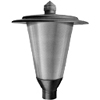
|
post top pt 1033
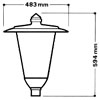 For group B lighting. A versatile post top lantern designed for use with 80/125 watt
MBF/U lamp (3 pin BC lampholder) and with 75x75mm spigot. The canopy top is an aluminium spinning,
gasketed to the opal acrylic bowl. Access to the interior of the lantern is obtained by removing
the canopy which is secured to the body of the lantern by means of a twist lock type
photo-electric cell.
For group B lighting. A versatile post top lantern designed for use with 80/125 watt
MBF/U lamp (3 pin BC lampholder) and with 75x75mm spigot. The canopy top is an aluminium spinning,
gasketed to the opal acrylic bowl. Access to the interior of the lantern is obtained by removing
the canopy which is secured to the body of the lantern by means of a twist lock type
photo-electric cell.
|
|
PT 1033
|
80-125W MBF/U
|
3BC
|
Post Top
|
No Gear
|
Sheet from 1970s
|
|
|

|
|
|

|
silver ray majestic
Cut off version
|
|
HW 1178
|
??? MBF/U
|
???
|
Side Entry
|
???
|
1960s Catalogue
|
|
|

|
eleco-way 1179 post top
 A general all-round illumination is obtained with a pleasing appearance and absence of glare.
Another very modern and pleasing Post Top design, which is durable, strong, and lightweight. The canopy top is
an aluminium spinning, gasketted to the perspex bowl, and secured by a cental die-cast nut. This base can be
supplied to fit the majority of standard spigots; it is cast in corrosion resistant aluminium alloy (LM6). This
base is fitted with a porcelain connector block, earth screw, cable clamp, and lampholder supports. Standard
finish is stove enemelled white inside and aluminium outside. Other colours in the I.C.I. range can be supplied
to special order. AN OUTSTANDING FEATURE OF THE PERSPEX BOWL IS ITS SINGLE PIECE, DEEP DRAWN CONSTRUCTION,
THE ABSENCE OF SEAMS OR JOINS GIVES MAXIMUM STRENGHT AND RIGIDITY. The lantern is supplied with spigot cap
suitable either B.S. 3" x 3" or to suit ELECOslim columns. Location is by Allen screws.
A general all-round illumination is obtained with a pleasing appearance and absence of glare.
Another very modern and pleasing Post Top design, which is durable, strong, and lightweight. The canopy top is
an aluminium spinning, gasketted to the perspex bowl, and secured by a cental die-cast nut. This base can be
supplied to fit the majority of standard spigots; it is cast in corrosion resistant aluminium alloy (LM6). This
base is fitted with a porcelain connector block, earth screw, cable clamp, and lampholder supports. Standard
finish is stove enemelled white inside and aluminium outside. Other colours in the I.C.I. range can be supplied
to special order. AN OUTSTANDING FEATURE OF THE PERSPEX BOWL IS ITS SINGLE PIECE, DEEP DRAWN CONSTRUCTION,
THE ABSENCE OF SEAMS OR JOINS GIVES MAXIMUM STRENGHT AND RIGIDITY. The lantern is supplied with spigot cap
suitable either B.S. 3" x 3" or to suit ELECOslim columns. Location is by Allen screws.
|
|
HW 11790
|
100-200W GLS
80-125W MBF/U
|
BC
3BC
|
Post Top
|
No Gear
|
1959 Catalogue
1960s Catalogue
|
|
HW 11791
|
45-60W SOI
|
BC
|
Post Top
|
No Gear
|
1959 Catalogue
1960s Catalogue
|
|
HW 1180
|
100-200W GLS
80-125W MBF/U
|
BC
3BC
|
Post Top
|
No Gear
|
1959 Catalogue
1960s Catalogue
|
|
HW 11801
|
45-60W SOI
|
BC
|
Post Top
|
No Gear
|
1959 Catalogue
1960s Catalogue
|
|
|

|
post top pt 1179 (respecified version of above)
 For group B lighting. A versatile post top lantern designed for use with 80/125 watt
MBF/U lamp. The canopy top is an aluminium spinning, gasketed to the opal acrylic bowl and
secured by a central die-cast knob. This allows quick and easy access to the interior of the
lantern for maintenance purposes. Also available is a 35W SOX version with the same
catalogue number.
For group B lighting. A versatile post top lantern designed for use with 80/125 watt
MBF/U lamp. The canopy top is an aluminium spinning, gasketed to the opal acrylic bowl and
secured by a central die-cast knob. This allows quick and easy access to the interior of the
lantern for maintenance purposes. Also available is a 35W SOX version with the same
catalogue number.
|
|
PT 1179
|
80-125W MBF/U
|
3BC/ES
|
Post Top
|
No Gear
|
Sheet from 1970s
|
|
PT 1179
|
35W SOX
|
BC
|
Post Top
|
No Gear
|
Sheet from 1970s
|
|
|

|
silver ray majestic
Semi-Cut off version
|
|
HW 1187
|
??? MBF/U
|
???
|
Side Entry
|
???
|
1960s Catalogue
|
|
|
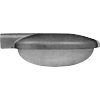
|
silver ray minor
 Corrosion resistant die-cast aluminium alloy (LM6M) canopy and bowl ring;
vandal resistant C.A.B. bowl. Canopy stove enamelled. Fully gasketted to eliminate dirt and moisture; fitted
porcelain terminal block and earth screw. Porcelain B.C. lampholder with heat resisting leads. Stainless steel hinge pin and
quick action toggle catch. A general all round illumination is obtained with a pleasing absence of
glare. Side entry 1" BS plain pipe 3¼" maximum length, secured by two Allen screws. Weight 3¼ lbs.
Corrosion resistant die-cast aluminium alloy (LM6M) canopy and bowl ring;
vandal resistant C.A.B. bowl. Canopy stove enamelled. Fully gasketted to eliminate dirt and moisture; fitted
porcelain terminal block and earth screw. Porcelain B.C. lampholder with heat resisting leads. Stainless steel hinge pin and
quick action toggle catch. A general all round illumination is obtained with a pleasing absence of
glare. Side entry 1" BS plain pipe 3¼" maximum length, secured by two Allen screws. Weight 3¼ lbs.
|
|
HW 1239
|
60-100W GLS
80-125W MB/U
|
BC
3BC
|
Side Entry
|
No Gear
|
Sheet from 1965
|
|
|

|
|
|
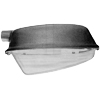
|
|
|



